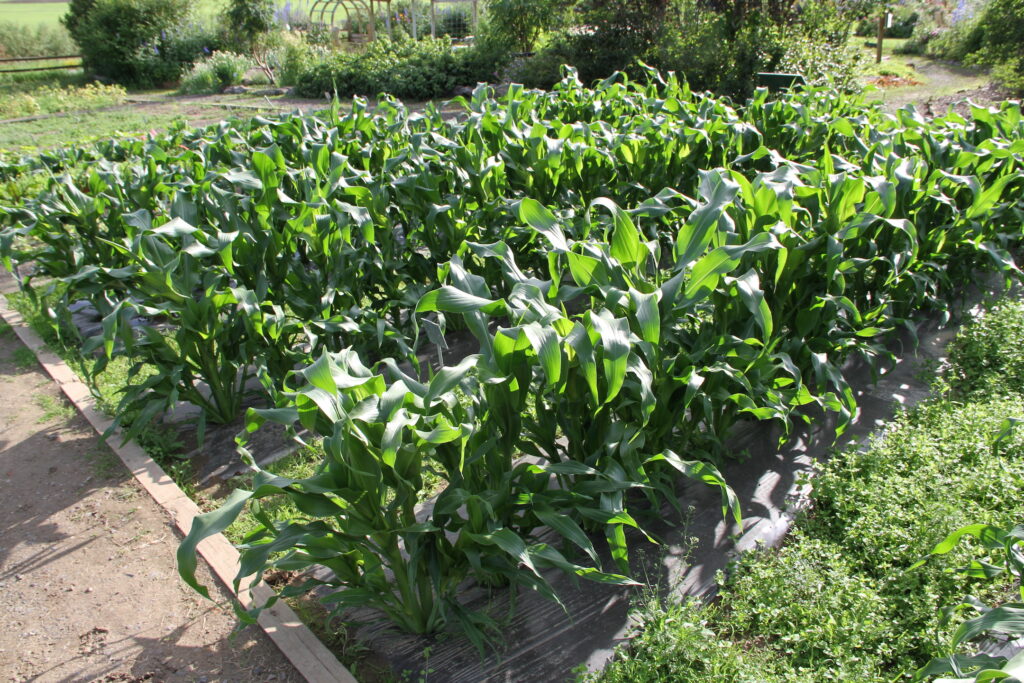Growing corn in Alaska is a pain in the neck. If you’re lucky, the summer is hot and you get a few ears. If you’re not lucky, and the summer is cold and rainy, you get zilch. Either way, a lot of effort and garden space goes into your attempts with mixed results.

Heidi Rader prepares to plant corn seedlings. They were seeded in a greenhouse on May 4th and planted on June 3rd and were a tad larger than ideal. Photo by Glenna Gannon.
Still, Alaska gardeners’ eyes light up when you talk about growing corn in a way you don’t see when you mention, say, kale, which is so much more reliable, nutritious and higher-yielding. Maybe part of the allure of growing corn is the challenge. Or maybe that it’s about 10 times sweeter than kale. If you get a twinkle in your eye when you hear corn-growing talk, here are some things you should know.
First, you will want to choose a variety that matures in around 70 days or less. You’ll also want to consider the genetics of the corn variety you’re selecting and not just for curiosity’s sake. It’s important for predicting cold hardiness, sweetness, seedling vigor (in cold soils), the shelf life or rate that sugar turns to starch and isolation requirements. I’m not going to lie, it’s a little bit confusing, but Delaware Cooperative Extension, does a great job of delineating the corn by their genetic traits. Johhny’s Seeds also provides a nice comparison of sweet corn types.For Alaska, synergistic varieties are a good bet. They are tasty, have vigorous seedlings and a long shelf life. In corn with longer shelf lives, the sugar is not converted to starch right away as opposed to normal (Su) sugar corn, which basically has no shelf life. Of course, when you grow your own corn in Alaska, you’re probably not going to be harvesting so much that you need to store it—you can pick it and plop it on the table directly.
But if you did want to grow a lot of corn (i.e. if you’re a farmer), then you might want to consider shelf life. Sugary enhanced (Se) corn has a better shelf life than normal (Su) corn and a creamy, tender texture that some consider mushy. In general, I would stay away from the super sweet types or other types with lower seedling vigor and longer days to maturity.
In our 2018 preliminary corn trials in Fairbanks, we noted a few distinctions between varieties, but in 2019, we had more robust data to share. Early Sunglow and Earlivee, both Su (normal sugary) varieties, lived up to their names and were the earliest. They produced decent yields of more than 8.6 and 7 pounds per 10-foot plot, respectively. Café corn (synergistic) had the highest overall yield overall at 14.2 pounds, followed by Sugar Pearl (sugary enhanced, Se). In taste trials, Sweetness ranked highest (5 of 5 for taste and 4 of 5 for texture), but Legend, Espresso, Spring Treat and Sugar Buns weren’t far behind with ratings of 4 of 5 for taste and texture.

There are several ways to give corn a jump start and optimize its chances for maturity in our short growing season. If direct-seeding, plant seeds about 8 to 12 inches apart in rows 30 to 36 inches apart around mid-May. You can plant at ground level, but I’ve heard some people use a bulb planter to dig a hole that allows the plant a few inches of growth before hitting the clear plastic that you’ll want to cover your seeds with after you plant them. When the plants are about 6 inches tall (taller if you planted them in a hole), cut slits into the plastic to allow the plants to emerge. Leave the plastic on the corn throughout the summer. Be forewarned—clear plastic will also help your weeds grow.
Alternatively, start seeds indoors 2 to 4 weeks before transplanting outside around May 15 to June 1 into a plastic mulch (preferably one like infrared transmitting mulch that acts as a soil warmer and weed barrier). Keep frost cloth handy if you plant closer to May 15 or cover the seedlings with additional, clear plastic supported by wire hoops until the corn outgrows it.
Don’t plant just one row of corn. Plant in a square or block to improve cross-pollination. Corn needs a lot of water and a lot of fertilizer. Drip irrigation or soaker hoses are the easiest way to water plants under plastic mulch. Watch your corn and note the date when about half of the corn has tasseled (half-silk date). They should be ready to harvest about 2 to 3 weeks after the half-silk date if the moose don’t get there first.
Watch a video about growing corn in Alaska here. For more help choosing which varieties to grow, see what Extension recommends for your the Interior and Southcentral region and which varieties performed best in trials. Minnesota Extension gives some additional tips on growing sweet corn.
I won’t waste my limited garden space on growing corn, but if you want to, go right ahead and be the envy of other Alaska gardeners.
Previously published in the Fairbanks Daily Newsminer July 6, 2019.
